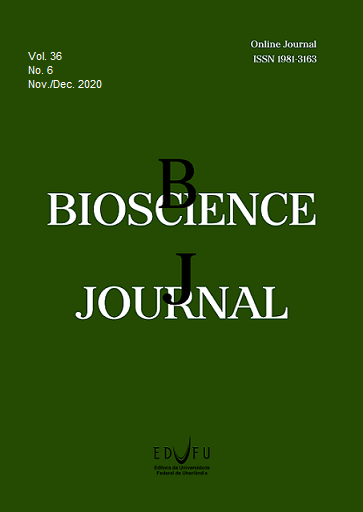Immunity of sugarcane cultivars to Meloidogyne enterolobii
DOI:
https://doi.org/10.14393/BJ-v36n6a2020-47972Keywords:
Saccharum spp., Root-knot nematode., Resistance., Reproduction factor., Non-host culture.Abstract
Brazil is currently the world’s largest producer and exporter of sugarcane, and the crop has high socioeconomic importance in the country. Root-knot nematodes (Meloidogyne spp.) are one of the major limiting factors in sugarcane production. These plant parasites have wide geographic distribution, high damage potential, and are difficult to control. Recently, the species Meloidogyne enterolobii was identified in sugarcane crops in the state of Pernambuco, Brazil. Given the importance of genetic resistance for integrated nematode management and the lack of research on the M. enterolobii–sugarcane pathosystem, this study aimed to assess the response of sugarcane cultivars to M. enterolobii. Thirteen cultivars were evaluated for their resistance to M. enterolobii based on the nematode reproduction factor. The experiment was conducted in a greenhouse, in a completely randomized design, with 14 replicates. Pre-sprouted sugarcane seedlings were transplanted to 5 L pots, and each pot was considered an experimental unit. At 15 days after transplanting, the seedlings were inoculated with 5,000 eggs and second-stage juveniles of M. enterolobii. Tomato and okra plants were also inoculated to test the viability of the inoculum. At 240 days after inoculation, plant roots were processed and evaluated for nematode number. This parameter was used to calculate the nematode reproduction factor on each cultivar. All sugarcane cultivars were found to be immune to M. enterolobii, with a reproduction factor of 0.
Downloads
Published
Issue
Section
License
Copyright (c) 2020 Gabriela Silva Thomazelli, Roberta Luiza Vidal, Lúcio Roberto Vizentini, Daniel Dalvan do Nascimento, Renato Silva Soares, Alexandre Fameli Mammana, Rivanildo Junior Ferreira, Pedro Luiz Martins Soares

This work is licensed under a Creative Commons Attribution 4.0 International License.





